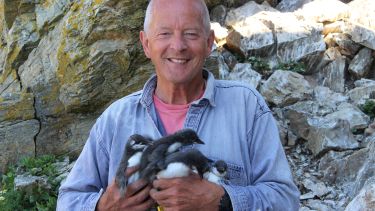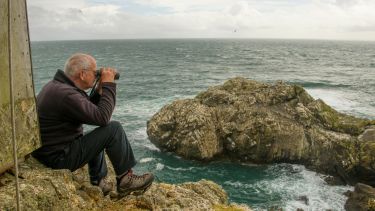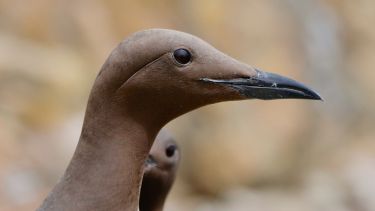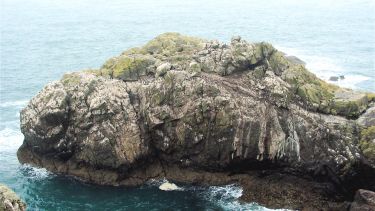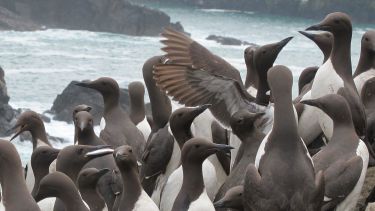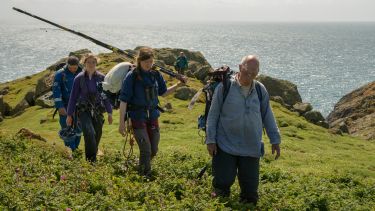- University of Sheffield scientist has dedicated his life to studying seabirds off the coast of the UK, in one of the world’s longest running studies of its kind
- Half a century study has revealed how climate change has caused mass mortality events, altered breeding times and how the population is now being devastated by bird flu
- The study is one of the most important in understanding how UK seabird populations are being affected by climate change and disease, as a second wave of bird flu sweeps across the UK
- Findings also reveal for the first time how the guillemot population works, uncovering fascinating new insights into their behaviour and social life, including their mass defence against predators and extramarital affairs
- A new generation of Sheffield scientists is fundraising to help protect the future of the research at a time when seabird monitoring is more important than ever
A scientist who has dedicated his life to studying seabirds has revealed how climate change has led to mass mortality events, altered breeding times and how the population is now being devastated by bird flu, in one of the world’s longest running studies of its kind.
Professor Tim Birkhead, from the University of Sheffield’s School of Biosciences, has spent the last 50 years studying a population of guillemots off the coast of the UK.
The study, which he started as a PhD student in 1973 and is now publishing as an emeritus professor at the same university half a century later, is one of the most important in understanding how UK seabird populations are being affected by climate change and disease, as a second wave of bird flu is sweeping across the UK.
Findings from the study show that the guillemot population, which is on Skomer Island, off the Pembrokeshire coast, and the most important seabird site in Southern Britain, is being hit hard by avian flu with thousands of guillemots having now been killed by the disease.
As bird flu is spreading, the Sheffield scientist fears the disease is nearing a catastrophe for the guillemots, who have been breeding on Skomer for hundreds of years and have already been hit hard by oil pollution, climate change, and now avian flu.
Professor Tim Birkhead, Emeritus Professor in the University of Sheffield’s School of Biosciences, said: “The current bird flu outbreak is potentially disastrous for Skomer’s guillemot population. Thousands have been killed so far and it looks like things may get worse.
“Skomer Island is one of the most important seabird sites in the UK – it’s home to a major proportion of the total number of guillemots and other seabirds in the whole of Britain – so to see them being so badly affected is heartbreaking.
“If avian flu continues to spread, this could turn into one of the biggest disasters to hit the UK’s seabird population.”
How climate change has affected guillemots
Aside from avian flu, the 50-year study has found that the guillemot population now breeds over two weeks earlier than it did in the 1970s. This may be related to the availability of the guillemot’s fish prey whose distribution and abundance has changed in recent decades due to climate change.
Climate change has also resulted in more extreme weather events, especially winter storms, which have caused mass mortality events - known in the seabird research community as wrecks. In 2014, extreme weather off the coast of Wales caused a sharp increase in guillemot deaths.
If this wasn’t enough, climate change means that extreme weather is now more frequent during the guillemot’s breeding season and is having a major impact on breeding success. Two major storms in May 2021 resulted in the direct loss of many guillemot eggs and reduced breeding success.
Professor Tim Birkhead said: “Over the last 50 years I’ve witnessed how climate change is affecting how guillemots live. Changes to the climate are making it more difficult for them to breed, find food and increasing the number of events that threaten the population’s very existence. Mass mortality events, or wrecks, have always occurred but they were once rare and seabirds have evolved to cope with them, but now their increased frequency is very worrying.”
How the guillemot population works
Professor Birkhead’s long term study has also shown that the guillemot population of Skomer works as a self-sustaining system and that their social life is complex and fascinating.
Professor Birkhead said: “Some seabirds spend much of their breeding season alone in a burrow, whereas guillemots typically breed out in the open, interacting continually with surrounding friends and family. I soon realised back in 1973 that the key to understanding guillemot biology at the colony was to work out why and how they breed in such close physical contact – at an average of about 20 pairs per square metre – with their conspecific neighbours.”
Guillemots lay their eggs together on open cliff ledges and defend them as a group from predatory gulls and ravens. Once known as the ‘Foolish Guillemot’, Professor Birkhead demonstrated how their bunching together, breeding synchronously, and sitting tight in the face of a predator is how guillemots successfully produce chicks. As a defence against gulls and corvids, sitting tight in a dense group is extremely effective, according to his work.
Guillemots are socially monogamous, forming long-term pair bonds, but males in particular rarely pass up the opportunity of copulating with a neighbour’s partner, usually only when the neighbouring male is absent.
Most extra-pair copulations are initiated by males and are successful only if the female co-operates. The monitoring found that if a male witnesses an extra-pair copulation attempt on his partner, his aggression is unrestrained. Professor Birkhead’s work in 2001 found, using molecular methods, that about seven per cent of chicks were fathered by a male other than the one that helped to rear them.
Professor Birkhead said: “Guillemots are endlessly fascinating, which is why I have continued to study them for fifty years. These birds are also a key component in the marine ecosystem, and to see them battered and knocked back by a succession of man-made (or anthropogenic) agents is hugely depressing. Guillemots are our monitors of the quality of the marine environment. They provide a clear signal about what we are doing to the planet.”
Fundraising for monitoring to continue
Despite 2023 marking 50 years since the study first started, funding is a major issue and threatens the future of the research.
The study was funded by the Countryside Council for Wales (CCW) - who owned and managed Skomer Island - but in 2014 CCW was absorbed by a new quango, Natural Resources Wales (NRW), which promptly terminated the funding to the dismay and disbelief of the UK seabird research community.
The University of Sheffield launched a crowdfunding campaign back in 2014, which thanks to the generosity of supporters, including Sheffield alumni, reached its target after two weeks to fund the project for one year.
Since then, the study has survived thanks to donations from philanthropists, but further funding is needed to enable the crucial research to continue.
Now that Professor Birkhead is emeritus and moving closer to full retirement, a new generation of scientists from Sheffield are fundraising to protect this vital monitoring of Skomer’s guillemots, which is more important than ever in the face of the double threats of climate change and avian flu.
Donate and support the long-term study of guillemots on Skomer Island
The study, Fifty years of Common Guillemot studies on Skomer Island, is published in British Birds. Read the paper in full
Contact
For further information please contact:

